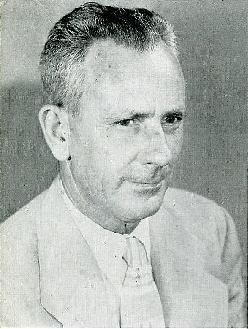
Dr. Hartley Price
Stars of Yesterday - Dr. Hartley Price
By Jim Joanos
Earlier this Fall, Florida State University's former gymnasts were honored. Several social events were held and a number of those former outstanding athletes were introduced to cheering fans attending the football game between FSU and the University of Tennessee-Chattanooga. The story of gymnastics at FSU includes five national championship teams, numerous individual national championships, and no less than 7 Olympians and 26 All-Americans. The man mostly responsible for that success was Hartley D'Oyley Price.
 |
Dr. Hartley Price |
In 1947, shortly after World War II ended, Florida State College for Women became coeducational and was renamed Florida State University. In the two years following that event, several men's intercollegiate athletic programs were begun at the school. Soon thereafter, at a physical education meeting in Kansas City, Missouri, FSU's athletic director, Howard Danford met Hartley Price, the gymnastics coach of the University of Illinois. At the time, Price had already attained major status in the fledgling sport of gymnastics. Following that meeting, Danford recruited and hired Price to come to FSU, teach physical education and begin a gymnastics program.
Hartley Price had been born in Brisbane, Australia in 1902, and came to the U.S. at the age of 21 to continue his education. He made his way to Springfield College and by 1927, he had obtained his B.S. degree in physical education. It was the first of five college degrees including a doctorate that Price would obtain during his lifetime. Following graduation, in 1927, Price became a faculty member of the University of Illinois. In 1930, he became the head gymnastics coach at Illinois. He became very successful as his teams won four national collegiate, two national AAU, and five Big Ten Conference championships.
Price's career, like that of so many other Americans was interrupted by World War II. Soon after Japan's attack upon Pearl Harbor, Price volunteered and entered the United States Navy. He would rise in rank to Lieutenant Commander during the war. Following the war's end, Price briefly returned to Illinois but soon thereafter he and wife, Billie, were headed to Tallahassee.
There was not much to work with when Price got to Tallahassee during the 1948-49 school year. The men's gymnasium was a temporary wooden structure previously built for the Army Air Corps training base located a couple of miles from the main campus. However, it did not take Price long to move things along. By the next school year he had the gymnastics program going. He had even begun a tumbling program for local children named the "Tallahassee Tumbling Tots." The program later became an integral part of the City of Tallahassee's recreation department and has served thousands of children through the years. It continues to this day.
Several seasoned gymnasts who had earlier planned to go to the University of Illinois followed Price to FSU. The most noteworthy was William H. "Bill" Roetzheim. FSU began intercollegiate competition in gymnastics in 1950 and went 4-0 in an abbreviated season. In addition to competing against other colleges, that team as well as the others that followed, also competed in Amateur Athletic Union events. At the time, AAU competition was keener than that of the NCAA as it included a larger group of amateur teams and athletes. In AAU competition that 1950 team won the Mid-West, Southeastern and Florida AAU championships. In the national AAU championships, Roetzheim won the All Around individual championship.
In 1951, at a meet in Ann Arbor, Michigan, FSU 's gymnastics team won the first ever NCAA Championship by a team from the State of Florida in any sport. They also won the AAU national championship held in Detroit, Michigan that same year. In the following summer, Roetzheim represented the United States at the first Pan American Games in Buenos Aires, Argentina, where he not only won first place in the horizontal bars competition, but also won the overall gymnastics individual championship. In 1952, the FSU team repeated as NCAA national champion. That summer, FSU gymnasts Bill Roetzheim and Don Holder competed as members of the U.S. team at the Olympic Games in Helsinki, Finland.
FSU remained very competitive at the national NCAA meets through 1959. The Seminoles won two more national AAU championships in 1953 and 55. Of special note was the FSU team's competion against national teams from other countries. In 1954 in Tallahassee, FSU took on the world champion Swedish National team and defeated them 50.5 to 45.5. The Seminoles repeated the following year when the touring Swedish team again came back to Tallahassee. In 1956, the FSU team traveled to Havana, and beat Cuba's National team.
Athletic director Howard Danford left FSU in 1957. Major changes took place later. Danford had been a big supporter of an all-around program that placed emphasis upon a large number of sports including volleyball and gymnastics. The athletics directors following him, faced with limited resources, cut down on the number of athletics teams to be financed. Major accomplishments in the sports of football, basketball and baseball resulted but the number of intercollegiate sports was reduced. Volleyball, as a varsity sport was curtailed after the 1957 season. Gymnastics hung on longer because of Dr. Price's and the teams popularity but ultimately by 1960 the school withdrew intercollegiate support for the sport.
For a number of years thereafter, Coach Price continued to lead the gymnastics team as a club sport. The team was even broadened to include greater emphasis upon women's participation.
Price retired from FSU in 1971 and died in Tallahassee in 1977. He was honored posthumously by inclusion in the FSU Athletics Hall of Fame in 1978. With Price's passing, FSU's pioneer role in the US's collegiate gymnastics world ended. It was a great run!